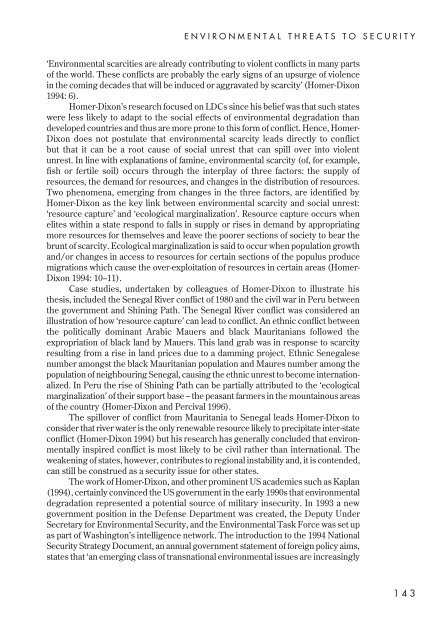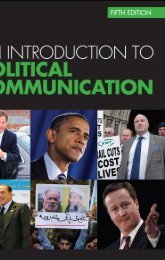Understanding global security - Peter Hough
Understanding global security - Peter Hough
Understanding global security - Peter Hough
Create successful ePaper yourself
Turn your PDF publications into a flip-book with our unique Google optimized e-Paper software.
ENVIRONMENTAL THREATS TO SECURITY<br />
‘Environmental scarcities are already contributing to violent conflicts in many parts<br />
of the world. These conflicts are probably the early signs of an upsurge of violence<br />
in the coming decades that will be induced or aggravated by scarcity’ (Homer-Dixon<br />
1994: 6).<br />
Homer-Dixon’s research focused on LDCs since his belief was that such states<br />
were less likely to adapt to the social effects of environmental degradation than<br />
developed countries and thus are more prone to this form of conflict. Hence, Homer-<br />
Dixon does not postulate that environmental scarcity leads directly to conflict<br />
but that it can be a root cause of social unrest that can spill over into violent<br />
unrest. In line with explanations of famine, environmental scarcity (of, for example,<br />
fish or fertile soil) occurs through the interplay of three factors: the supply of<br />
resources, the demand for resources, and changes in the distribution of resources.<br />
Two phenomena, emerging from changes in the three factors, are identified by<br />
Homer-Dixon as the key link between environmental scarcity and social unrest:<br />
‘resource capture’ and ‘ecological marginalization’. Resource capture occurs when<br />
elites within a state respond to falls in supply or rises in demand by appropriating<br />
more resources for themselves and leave the poorer sections of society to bear the<br />
brunt of scarcity. Ecological marginalization is said to occur when population growth<br />
and/or changes in access to resources for certain sections of the populus produce<br />
migrations which cause the over-exploitation of resources in certain areas (Homer-<br />
Dixon 1994: 10–11).<br />
Case studies, undertaken by colleagues of Homer-Dixon to illustrate his<br />
thesis, included the Senegal River conflict of 1980 and the civil war in Peru between<br />
the government and Shining Path. The Senegal River conflict was considered an<br />
illustration of how ‘resource capture’ can lead to conflict. An ethnic conflict between<br />
the politically dominant Arabic Mauers and black Mauritanians followed the<br />
expropriation of black land by Mauers. This land grab was in response to scarcity<br />
resulting from a rise in land prices due to a damming project. Ethnic Senegalese<br />
number amongst the black Mauritanian population and Maures number among the<br />
population of neighbouring Senegal, causing the ethnic unrest to become internationalized.<br />
In Peru the rise of Shining Path can be partially attributed to the ‘ecological<br />
marginalization’ of their support base – the peasant farmers in the mountainous areas<br />
of the country (Homer-Dixon and Percival 1996).<br />
The spillover of conflict from Mauritania to Senegal leads Homer-Dixon to<br />
consider that river water is the only renewable resource likely to precipitate inter-state<br />
conflict (Homer-Dixon 1994) but his research has generally concluded that environmentally<br />
inspired conflict is most likely to be civil rather than international. The<br />
weakening of states, however, contributes to regional instability and, it is contended,<br />
can still be construed as a <strong>security</strong> issue for other states.<br />
The work of Homer-Dixon, and other prominent US academics such as Kaplan<br />
(1994), certainly convinced the US government in the early 1990s that environmental<br />
degradation represented a potential source of military in<strong>security</strong>. In 1993 a new<br />
government position in the Defense Department was created, the Deputy Under<br />
Secretary for Environmental Security, and the Environmental Task Force was set up<br />
as part of Washington’s intelligence network. The introduction to the 1994 National<br />
Security Strategy Document, an annual government statement of foreign policy aims,<br />
states that ‘an emerging class of transnational environmental issues are increasingly<br />
143
















